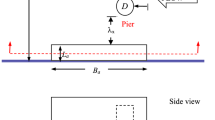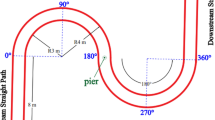Abstract
Local scour is a phenomenon considering a three-dimensional flow system which sets up around bridge piers and abutments constructed in alluvial bed rivers. The process of local scour can bring about partial inability or complete breakdown of bridge supports and decks. The current investigation involves a series of analyses to determine the effect of mutual interference of bridge piers of various materials with varying distances between them and express the observations with the distinctive parameters of the analysis. With an isolated single pier as standard, tests with piers of five different materials were conducted under clear water conditions. The outcome revealed that the interference between two piers was most prominent at a spacing of two times the pier diameter which was then reduced at increased pier spacing. However, at a spacing of about eight times the pier diameter, the two piers behave as individual piers without affecting the scour depths around the other pier. Further, the surface roughness of the pier bears an inverse relation with scour depth and the interference effects get reduced with increasing surface roughness of the pier. In addition, the increase in the Froude number results in an increase in the scour depth around both upstream and downstream piers and the critical spacing ratio at which the interference is maximum increases with increasing Froude number. Following the experimental outcomes of the present analysis, a model for equilibrium scour depth at complex piers is formulated and validated.












Similar content being viewed by others
Abbreviations
- \(D\) :
-
Pier diameter
- \(D_{10}\) :
-
Effective size
- \(D_{30}\) :
-
Size at which 30% is finer by weight
- \(D_{50}\) :
-
Median grain size
- \(D_{60}\) :
-
Size at which 60% is finer by weight
- \(F_{r}\) :
-
Froude number
- \(q\) :
-
Discharge intensity
- \(C_{d}\) :
-
Coefficient of discharge
- \(y\) :
-
Flow depth
- \(X\) :
-
Clear spacing between two in-line piers
- \(X\)/\(D\) :
-
Pier spacing ratio (ratio of spacing between piers and pier diameter)
- \(D_{s}\) :
-
Maximum scour depth around individual pier
- \(D_{s1}\) :
-
Maximum scour depth around upstream pier for two in-line piers
- \(D_{s2}\) :
-
Maximum scour depth around downstream pier for two in-line piers
- \(C_{u}\) :
-
Uniformity coefficient
- \(C_{c}\) :
-
Coefficient of curvature
- \(f\) :
-
Silt factor
- \(k\) :
-
Absolute surface roughness of the pier materials
References
Shahriar AR, Gabr MA (2021) Bridge Pier Scour: an overview of factors affecting the phenomenon and comparative evaluation of selected models. Transp Geotech. https://doi.org/10.1016/j.trgeo.2021.100549
Pizarro A, Manfreda S, Tubaldi E (2020) The Science behind scour at Bridge foundations: a review. Water. https://doi.org/10.3390/w12020374
Malik R, Setia B (2013) Experimental study on behaviour of closely placed bridge pier models. National Conference on Current Advances in Hydraulics, Hydropower Engineering and Water Conservation (CAHHEWC-2013), National Institute of Technology Kurukshetra
Keaton Jeffrey R, Mishra Subhendu K, Clopper Paul E (2010) Scour at bridge foundations on rock: overview of NCHRP Project No. 24–29. In: Proceedings 5th international conference on scour and erosion (ICSE-5), San Francisco, USA Reston, Va: American Society of Civil Engineers, pp 749–756
Duan H, Cao J, Zhang Y, Huang Y, Wei S, Jiang Y (2021) Summary of research on evaluation of local scour around bridge pier. IOP Conf Ser Earth Environ Sci. https://doi.org/10.1088/1755-1315/692/4/042023
Rady RAE (2020) Prediction of local scour around bridge piers: Artificial-intelligence-based modelling versus conventional regression methods. Appl Water Sci. https://doi.org/10.1007/s13201-020-1140-4
Deng L, Cai CS (2010) Bridge scour: prediction, modelling, monitoring, and countermeasures-review. Pract Period Struct Des Constr 15(2):125–134. https://doi.org/10.1061/(ASCE)SC.1943-5576.0000041
Ferraro D, Tafarojnoruz A, Gaudio R, Cardoso AH (2013) Effects of pile cap thickness on the maximum scour depth at a complex pier. J Hydraul Eng 139(5):482–491. https://doi.org/10.1061/(ASCE)HY.1943-7900.0000704
Barkdoll BD (2012) Effects of climate change on bridge scour. World Environ Water Resour Congress 2012:2532–2537. https://doi.org/10.1061/9780784412312.253
Alexandros NK, Imam B (2016) Probabilistic assessment of local scour in bridge piers under changing environmental conditions. Struct Infrastruct Eng 12(9):1228–1241. https://doi.org/10.1080/15732479.2015.1102295
Laursen EM, Toch A (1956) Scour around bridge piers and abutments. Bulletin No 4. Iowa Highway Research Board, Bureau of Public Roads, Iowa
Breusers HNC, Raudkivi AJ (1991) Scouring. Hydraulic structures design manual, Vol 2, AA Balkmea, Rotterdam
Kothyari UC, Garde RCJ, Raju KGR (1992) Temporal variation of scour around circular bridge piers. J Hydraul Eng 118:1091–1106
Melville BW (1997) Pier and abutment scour: integrated approach. J Hydraul Eng 123(2):125–136
Heza YBM, Soliman AM, Saleh SA (2007) Prediction of the scour hole geometry around exposed bridge circular-pile foundation. J Eng Appl Sci 54(4):375–392
Hafez YI (2016) Mathematical modelling of local scour at slender and wide bridge piers. J Fluids. https://doi.org/10.1155/2016/4835253
Mir BH, Lone MA, Bhat JA (2017) Effect of obstacle material type on local scour. Int J Adv Struct Geotech Eng 6(3):114–119
Mir BH, Lone MA, Bhat JA, Rather NA (2018) Effect of gradation of bed material on local scour depth. Geotechnol Geol Eng 36:2505–2516
Mir BH, Lone MA, Rather NA (2019) Significance of shape factor of obstacle on local scour. Iran J Sci Technol Trans Civil Eng 43(1):S323–S330
Qi M, Li J, Chen Q (2016) Comparison of existing equations for local scour at bridge piers: parameter influence and validation. Nat Hazards 82:2089–2105. https://doi.org/10.1007/s11069-016-2287-z
Vonkeman JK, Basson GR (2019) Evaluation of empirical equations to predict bridge pier scour in a non-cohesive bed under clear-water conditions. J South Afr Inst Civil Eng https://doi.org/10.17159/2309-8775/2019/v61n2a1
Annad M, Lefkir A, Mammar-Kouadri M, Bettahar I (2021) Development of a local scour prediction model clustered by soil class. Water Practice Technol 16(4):1159–1172. https://doi.org/10.2166/wpt.2021.065
Ghaderi A, Abbaszadeh Shahri A, Larsson S (2019) An artificial neural network based model to predict spatial soil type distribution using piezocone penetration test data (CPTu). Bull Eng Geol Env 78:4579–4588. https://doi.org/10.1007/s10064-018-1400-9
Sumer BM, Bundgaard K, Fredsoe J (2005) Global and local scour at pile groups. In: Fifteenth international offshore and polar engineering conference, Seoul, Korea
Ataie-Ashtiani B, Baratian GZ, Beheshtia A (2010) Experimental investigation of clear water local scour of compound piers. J Hydraul Eng 136(6):343–351
Amini A, Melville BW, Ali TM, Ghazali AH (2012) Clear-water local scour around pile groups in shallow-water flow. J Hydraul Eng 138:177–185. https://doi.org/10.1061/(ASCE)HY.1943.7900.0000488
Malik R, Setia B (2019) Interference Effects around Bridge Piers- A Review of Parameters. J Indian Water Resour Soc 38(4)
Malik R, Setia B (2020) Interference between pier models and its effects on scour depth. SN Appl Sci. https://doi.org/10.1007/s42452-019-1868-3
Malik R, Setia B (2020) Prediction of scour depth around bridge piers in tandem arrangement using M5 and ANN regression models. Arch Mater Sci Eng 102(2):49–58. https://doi.org/10.5604/01.3001.0014.1524
Hassan ZF, Karim I, Shukur AHK (2020) Effect of interaction between bridge piers on local scouring in cohesive soils. Civil Eng J 6(4), 659–669. https://doi.org/10.28991/cej-2020-03091498
Khaple S, Hanmaiahgari PR, Gaudio R, Dey S (2017) Interference of an upstream pier on local scour at downstream piers. Acta Geophys 65:29–46. https://doi.org/10.1007/s11600-017-0004-2
Hannah CR (1978) Scour at pile groups. Univ Canterbury, NZ, Civil Eng Res REP, No 78–3:92
Movahedi N, Dehghani AA, Aarabi MJ, Zahiri AR (2013) Temporal evolution of local scour depth around side-by-side piers. J Civil Eng Urban 3(3):82–86
Beg M (2004) Mutual Interference of bridge piers on local scour. In: Proceeding’s 2nd international conference on scour and erosion (ICSE-2), Nanyang Technological University, Singapore
Keshavarzi A, Shrestha CK, Melville B, Khabbaz H, Zahedani MR, Ball J (2018) Estimation of maximum scour depths at upstream of front and rear piers for two in-line circular columns. Environ Fluid Mech 18(2):537–550. https://doi.org/10.1007/s10652-017-9572-6
Khan KA, Muzzammil M, Alam J (2016) Bridge pier scour: a review of mechanism, causes and geotechnical aspects. In: Proceedings of advances in geotechnical engineering, national conference on ‘advances in geotechnical engineering’ (AGE-2016), Aligarh Muslim University, India
Barry JJ, Buffington JM, King JG (2004) A general power equation for predicting bed load transport rates in gravel bed rivers. Water Resourc Res. https://doi.org/10.1029/2004WR003190
Asheghi R, Hosseini SA, Sanei M (2021) Intelligent hybridized modeling approach to predict the bedload sediments in gravel-bed rivers. Model Earth Syst Environ. https://doi.org/10.1007/s40808-021-01165-w
Chiew YM, Melville BW (1987) Local scour around bridge piers. J Hydraul Res 25(1):15–26
Ettema R (1980) Scour at bridge piers. Reg No 216, School of Engineering, Auckland University, Auckland
Yang Y, Qi M, Wang X, Li J (2020) Experimental study of scour around pile groups in steady flows. Ocean Eng. https://doi.org/10.1016/j.oceaneng.2019.106651
Igarashi T (1981) Characteristics of the flow around two circular cylinders arranged in tandem: 1st report. Bull JSME 24(188):323–331. https://doi.org/10.1299/jsme1958.24.323
Abbaszadeh Shahri S, Larrson S, Renkel C (2020) Artificial intelligence models to generate visualized bedrock level: a case study in Sweden. Model Earth Syst Environ 6:1509–1528. https://doi.org/10.1007/s40808-020-00767-0
Melville BW, Coleman SE (2000) Bridge scour. Water Resources Publications, Denver
Sheppard DM, Melville B, Demir H (2014) Evaluation of existing equations for local scour at bridge piers. J Hydraul Eng 140:14–23
Hamby DM (1994) A review of techniques for parameter sensitivity analysis of environmental models. Environ Monit Assess 32:135–154
Gaudio R, Tafazojnoruz A, Bartolo SD (2013) Sensitivity analysis of bridge pier scour depth predictive formulae. J Hydroinf 15(3):939–951. https://doi.org/10.2166/hydro.2013.036
Asheghi R, Hosseini SA, Saneie M, Shahri AA (2020) Updating the neural network sediment load models using different sensitivity analysis methods: a regional application. J Hydroinf 22(3):562–577. https://doi.org/10.2166/hydro.2020.098
DaDalt PJ, Wolf JG (2020) Sensitivity and Simulation Analysis in Excel Without Programming. https://ssrn.com/abstract=3623496
Acknowledgements
The authors of this paper are highly grateful to the staff of Fluid Mechanics Laboratory of the National Institute of Technology, Srinagar, for providing every facility for carrying out the experimental work for this research.
Author information
Authors and Affiliations
Corresponding author
Ethics declarations
Conflict of interest
The authors declare that they have no known competing financial interests or personal relationships that could have appeared to influence the work reported in this paper.
Rights and permissions
Springer Nature or its licensor (e.g. a society or other partner) holds exclusive rights to this article under a publishing agreement with the author(s) or other rightsholder(s); author self-archiving of the accepted manuscript version of this article is solely governed by the terms of such publishing agreement and applicable law.
About this article
Cite this article
Jan, R., Lone, M.A. Effect of mutual interference of piers on their local scour phenomenon. Innov. Infrastruct. Solut. 7, 186 (2022). https://doi.org/10.1007/s41062-022-00790-3
Received:
Accepted:
Published:
DOI: https://doi.org/10.1007/s41062-022-00790-3




